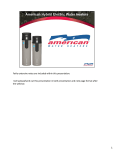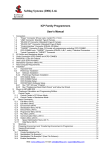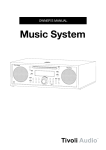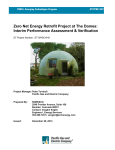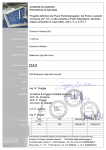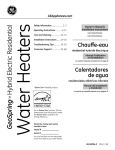Download Rheem Electric Residential Heat Pump Water Heaters Installation guide
Transcript
Heat Pump Water Heaters Selection and Quality Installation Guide SPONSERED BY: Cape Light Compact PREPARED BY: June 7, 2012 Contents 1 2 3 Background ........................................................................................................................................... 1 What Are Heat Pump Water Heaters? ................................................................................................ 2 HPWH Performance .............................................................................................................................. 3 3.1 Performance Metrics ...........................................................................................................3 3.2 Performance and Potential Savings .....................................................................................3 3.3 What Affects Performance? .................................................................................................5 3.3.1 Hot Water Usage ......................................................................................................5 3.3.2 Ambient Air Temperature ........................................................................................5 3.3.3 Inadequate Space .....................................................................................................6 3.3.4 Tank Set Point Temperature ....................................................................................6 3.4 Dehumidification .................................................................................................................6 3.5 Interaction with Space Conditioning Systems .....................................................................6 3.6 Reliability and Safety...........................................................................................................7 4 Selecting Locations for HPWHs .......................................................................................................... 7 4.1 Space Requirements .............................................................................................................7 4.2 Heating and Cooling Considerations ...................................................................................8 4.3 Noise…. .............................................................................................................................10 5 6 Selecting a HPWH Model ................................................................................................................... 10 HPWH Installation ............................................................................................................................... 11 6.1 Size, Weight, and Space.....................................................................................................11 6.2 Managing Condensate........................................................................................................11 6.3 Drain Pans and Blocks .......................................................................................................12 6.4 Heat traps ...........................................................................................................................12 6.5 Tempering Valves and Set Point Temperature ..................................................................13 7 Operation and Maintenance .............................................................................................................. 14 7.1 Filter Maintenance .............................................................................................................14 7.2 Inspect Condensate Drains .................................................................................................15 7.3 Typical Water Heater Maintenance ...................................................................................15 References ................................................................................................................................................. 16 1 Background Heat pump water heaters (HPWHs) promise to significantly reduce energy consumption for domestic hot water (DHW) over standard electric resistance water heaters (ERWHs). Water heater efficiency is usually described by the energy factor (EF). Typical electric resistance water heaters have EFs of 0.9 or above, which means that the heaters are over 90% efficient in converting electricity into thermal energy in the water heater. New HPWHs have EFs of 2.0 to 2.5, meaning that HPWHs can use less than half the energy that a standard electric tank would require. High energy factors in HPWHs are achieved by combining a vapor compression system, which extracts heat from the surrounding air at high efficiencies, with electric resistance element(s), which are able to help meet larger hot water demands. In New England homes, water heating is responsible for 17% of total energy consumption – the largest energy use in homes after space heating. In the Northeast, 1.4 million households (26%) use electricity as their primary water heating fuel 1 and consume – on average – over 2,600 kWh each year to heat water. 2 In many cases, switching to a HPWH can cut this consumption in half, saving several hundred dollars per year in the “average” home. Although HPWHs cannot be installed in all locations, they do offer significant energy saving potential. Although HPWHs were first commercialized in the 1980s, they were typically add-ons to existing water heaters (i.e. a heat pump would pump water from a tank water heater, heat it outside the tank, and pump it back into the tank). These systems required specialized knowledge for installation and sometimes required both an HVAC contractor and a plumber to install the system. The development of integrated or “drop-in” HPWHs (where the heat pump and tank are integrated within a single appliance) allowed for easy installation by a single trade (Tomlinson 2002). While integrated HPWHs are not entirely new, earlier residential products (available around 2000) achieved minimal market penetration and experienced reliability issues Recently several manufacturers, including General Electric (GE), Rheem, AO Smith, Stiebel Eltron, and Air Generate, have introduced integrated HPWHs (Table 1). Integrated refers to the fact that the units are packaged replacements for conventional ERWH tanks; they include the hot water tank, heat pump, backup resistance heating elements, and all controls. The demand for these integrated HPWHs has been fueled by higher electricity rates and the availability of various incentives (state, federal, local, utility, etc.) that promote the installation of more efficient equipment. Furthermore, the new Federal water heater standard, which takes effect in 2015, mandates EFs around 2.0 for all new electric storage water heaters with capacities greater than 55 gallons (Federal Register 2010). This regulation will effectively mandate the use of HPWHs in applications with large hot water demands and where electricity will be used to heat water. 1 2 Figure 1. An integrated HPWH installed in a basement. http://38.96.246.204/emeu/recs/recs2005/c&e/waterheating/pdf/tablewh2.pdf http://www.eia.gov/consumption/residential/data/2005/c&e/waterheating/pdf/tablewh6.pdf 1 Table 1. Key Specifications of some integrated HPWHs currently available in the US market. Model GE GeoSpring™ AO Smith Voltex® Stiebel Eltron Accelera®300 AirGenerate AirTap™ Integrated Capacity (gal) 50 60 / 80 80 Energy Factor 2.35 2.33 2.51 First Hour Rating (gal) 63.0 68.0 / 84.0 78.6 50 / 66 2.39 / 2.40 60.0 / 75.0 2 What Are Heat Pump Water Heaters? A “heat pump” is a device that moves heat from one place to another; it works much like an air conditioner or a refrigerator. While a refrigerator moves heat from inside the fridge into your kitchen, a heat pump water heater (HPWH) moves heat from your basement or mechanical room into the hot water tank. HPWHs are primarily designed as replacements for standard, electric resistance water heater tanks (ERWHs). HPWHs are able to achieve higher efficiencies (and energy factors) through use of the vapor compression heat pump cycle. Auxiliary electric resistance elements are also installed for reliability and quicker hot water recovery. Most heat pumps operate as “hybrid” devices – i.e. they use the heat pump whenever possible, but built-in controls switch to conventional resistance heating when there are large hot water needs. Figure 2. Simple schematic of HPWH operation. 2 The heat pumps in these hybrid water heaters can heat water at high efficiencies, but the heat pumps have heating capacities lower than those of traditional electric resistance elements. Typical 4.5-kW electric resistance elements, for example, can reliably heat over 20 gallons of water per hour. The heat pump has a lower heating rate; GE, for example, publishes a rate of 8 gallons per hour at 68°F air temperature. This gap illustrates the benefit of a “hybrid” configuration – heat pumps are used when possible for highest efficiency, but resistance heat is used when there’s high demand for hot water. Heaters with larger storage tanks generally revert to backup heating less often than lowervolume heaters. Most HPWHs have several operating modes (manually adjustable by the users): • “Hybrid mode” is typically the default; it uses both the electric resistance element(s) and the heat pump to meet demand, but it uses the heat pump whenever possible to maximize efficiency. • “Heat pump mode” uses only the heat pump. This can improve efficiency, but it dramatically reduces the recovery capacity of the water heater. If occupants use a great deal of hot water in a short period of time, they may run out of hot water sooner and it will take longer to heat more water. • “Electric resistance mode” works like a traditional ERWH. This mode can be used when cooling effects from the heat pump aren’t desired or if there is a problem with the heat pump. The names of these modes differ by manufacturer, but most models include some combination of the above operating modes. 3 HPWH Performance 3.1 Performance Metrics The efficiency of residential water heaters in the United States is measured and reported using the energy factor (EF) value. The energy factor represents the efficiency of the electric element and tank losses under a specifc 24-hour test procedure (Burch and Erickson 2004; Federal Register 1998). In the real world, people use water quite differently than in this rating test procedure. When talking about measured, real-world performance in this document the term “coefficient of performance” or COP is used to describe efficiency. COP is the ratio typically used to rate performances of heat pumps, air conditioners, etc. Like EF, COP is the unit-less ratio of useful energy output to energy input. In the standard test procedure described above, the COP would be equal to the EF. In the real world, COP can differ substantially from EF (for reasons discussed below). 3.2 Performance and Potential Savings Traditional electric resistance water heaters (ERWHs) provide hot water at rather high costs. Table 2 shows some example costs for several conventional water heating systems, and the electric resistance tank is among the highest-cost systems. Table 3 compares water heating costs for ERWH and a HPWH. 3 Table 2. Approximate water heating costs for a home consuming 55 gal/day of hot water. Costs are only examples; fuel cost, water use, and EF can vary considerably. Water Heater Type Fuel Cost EF* Annual Cost Electric Resistance Tank $0.17 /kWh 0.90 $650 Oil - Tankless Coil $3.60 /gal 0.50 $610 Oil - Indirect Tank $3.60 /gal 0.75 $410 Natural Gas Tank $1.50 /therm 0.59 $300 Natural Gas Tankless $1.50 /therm 0.80 $220 Condensing NG Tankless $1.50 /therm 0.92 $190 Propane Tank $3.50 /gal 0.59 $760 Propane Tankless $3.50 /gal 0.80 $560 * For appliances that aren't given EF ratings, such as boilers and indirect water heaters, this is a typical, effective value. Table 3. Example water heating costs, ERWH vs. HPWH. Water use and energy costs can vary substantially. Avg. Hot Annual Hot Water Cost No. Water Use Standard Tank People [Gal/day] (EF 0.9) HPWH 2 35 $410 $140 to $370 4 55 $650 $220 to $580 6 75 $880 $310 to $800 HPWH Savings $40 to $270 $70 to $430 $80 to $570 When replacing an ERWH, a HPWH usually results in substantial savings. Substantial savings are also possible when replacing other types of water heaters (such as boilers with tankless coils and propane heaters where propane prices are quite high). Despite the possibility of large savings, there is also potential for a wide range in HPWH operating costs (as Table 3 shows). The performance ranges in Table 3 come from an evaluation project of several HPWHs in New England homes. In 2010, several New England utilities (National Grid, NSTAR, and Cape Light Compact) sponsored the installation and evaluation of heat pump water heaters in 14 homes across the region. Steven Winter Associates, Inc. (SWA), with support from the U.S. DOE Building America Program, monitored the performance of these systems in detail for over a year. The results of the evaluation were encouraging. Most importantly, all customers were satisfied with the supply of hot water. With respect to efficiency, the measured COPs were largely in-line with manufacturer EF ratings. Table 4. Measured performance of 14 HPWHs installed in Massachusetts and Rhode Island homes. Measured COP Min. Average Max 1.0 1.9 2.6 4 The average, measured COP was more than twice the EF of typical electric resistance water heaters; this basically means that – on average – water heating costs were half what they would have been with ERWHs. The wide range in COPs shows that performance of HPWH’s can vary tremendously. The key factors that cause these variations are discussed in some detail below. 3.3 What Affects Performance? Energy used by HPWHs varies much more than for conventional ERWHs. The four main reasons for these variations are discussed below. 3.3.1 Hot Water Usage The primary driver of the efficiency and energy usage of a HPWH is hot water usage. Electricity consumption increases – and HPWH efficiency decreases – with both overall water consumption (i.e. average gallons used per day) and intensity of water consumption (i.e. gallons consumed over a short time period). During intense, high-volume hot water draws – such as several long, consecutive showers – a hybrid HPWH will often automatically switch to electric resistance heating. Electric resistance can provide more hot water faster, but it also consumes at least twice the electricity when compared to heat pump mode. Heaters with larger storage tanks can generally provide more hot water without resorting to backup heating. In short, homes where occupants use a moderate amount of hot water throughout the day will experience the highest efficiency from a HPWH. Homes that use large volumes of water – or use a great deal of water in short periods of time – will see lower efficiencies. Even in rather high-volume applications, however, energy costs will usually be substantially lower than with a standard electric resistance heater. 3.3.2 Ambient Air Temperature The efficiency of a HPWH increases substantially with increased ambient temperature (i.e. the air temperature of the space where the HPWH is located). Heat pumps become much more efficient when the heat source (in this case the ambient air) becomes warmer, and standby losses are lower when the surroundings are warmer. A higher air temperature also increases the heating capacity of the heat pump; this helps to minimize the use of back-up, electric resistance heating. According to manufacturer literature, most HPWHs will only operate in heat pump mode when ambient temperature is between approximately 45°F and 110°F. When the temperature of the incoming air drops below the minimum temperature, the HPWH will switch into electric resistance mode, reducing the efficiency of the unit. HPWHs also cool a space (they move heat from the ambient air into the water); tests and literature show that a HPWH will reduce ambient air temperatures by 2-6°F. For this reason, it’s recommended that HPWH be installed in spaces where the ambient air temperature – before the HPWH is installed – is at least 50-55°F for most of the year. Among the HPWHs evaluated in the study mentioned above (see summary in Table 4), one of the systems had an overall COP of 1.0; this is not much better than an electric resistance heater. The main reason that this COP is so far below the listed energy factor (2.3) was that the heater was installed in a remote, cold section of the basement. Air temperatures in this space were between 40°F and 55°F, and the HPWH often needed to operate in electric resistance mode. Even when in heat pump mode, the efficiency at such low air temperatures was very poor. 5 3.3.3 Inadequate Space To operate efficiently, a HPWH must be able to extract sufficient energy from the surrounding air, and the energy available in the air is a function of: • Temperature of the air • Volume of air available – i.e. the size of the space. HPWHs should be installed in rooms with adequate air volume to ensure efficient operation. See manufacturer literature for exact space requirements; a minimum volume of 750 ft3 is typical. In addition, adequate clearances must be provided to allow for proper airflow and maintenance (see Section 4.1). Among the systems evaluated in the study mentioned above (see Table 4), the system with the lowest overall COP (1.0) was installed in a very cold space. The second lowest COP (1.4) was observed in a home where the HPWH was installed in a small closet. Even with louvered doors, the closet did not have enough air for the HPWH to operate efficiently much of the time. As a result, the heater operated in resistance mode quite often, and water heating costs were higher than in most other homes. 3.3.4 Tank Set Point Temperature Unlike resistance water heaters, the efficiency of HPWHs depends largely on the hot water set point temperature. If a heater is programmed to provide hotter water, both the efficiency and the heating capacity of the heat pump are reduced. A heat pump will operate more efficiently heating water to 120°F than to 140°F. On the flip side of this, a tank of 140°F water can go further than a tank of 120°F water (providing another 10 minutes or so of a hot shower). Sometimes keeping a tank at 140°F will reduce the use of backup heating elements (which are much less efficient than the heat pump). It’s generally recommended, however, not to raise the tank temperature much above 120°F unless this results in a shortage of hot water or frequent use of the backup resistance heaters. 3.4 Dehumidification Because HPWHs remove heat from the ambient air using a heat pump refrigeration cycle, HPWHs also remove moisture from the air (much like an air conditioner or dehumidifier). The water vapor in the air condenses as it passes across the HPWH’s evaporator coils and, as a result, the HPWH will provide some dehumidification. When installed in a damp space (such as a basement) where a dehumidifier is used, a HPWH can sometimes cut down on the time that the dehumidifier needs to operate. 3.5 Interaction with Space Conditioning Systems While all discussion of “efficiency” and “performance” has so far focused on the HPWH alone, HPWHs can have an impact on the space conditioning systems in a house. As mentioned above, HPWHs transfer heat from the ambient air to water, thereby cooling the ambient air. This effect is usually a welcome benefit during summer months, but during the heating season, the home’s heating equipment will need to make up for some of this energy. 6 In the Northeast, placing HPWHs within conditioned space will require the heating systems to consume more energy. Even when installed in basements – which may not be fully “conditioned” – HPWHs may require the space heating systems to generate more heat overall. These interactions are certainly something to consider, but they are very difficult to quantify. There will always, however, be overall savings when compared to a standard electric resistance water heater. In a worst-case scenario, the HPWH would run in electric resistance mode all winter. During the warmer months, however, there will be benefit from the higher heat pump COP along with some free cooling and dehumidification. A HPWH may also alter comfort in areas of a home: in the summer, the cooling and dehumidification can be beneficial, but the cooling may provide comfort problems during the winter. Carefully consider the HPWH location within a home, and if seasonal comfort problems are a real concern, most HPWHs can be manually adjusted to resistance mode during the coldest spells. 3.6 Reliability and Safety The integrated HPWH appliances currently available have only been on the market since approximately 2009-2010. While it is logical that the higher complexity of HPWHs over standard ERWHs could lead to greater failure rates and higher maintenance costs, the HPWH models currently available do not seem to be experiencing significant reliability issues. As these systems have been installed for only 2-3 years (at the writing of this document), it’s premature to predict longer-term reliability. Initial evaluations, however, do not seem to hint at any longer-term performance concerns. 4 Selecting Locations for HPWHs 4.1 Space Requirements HPWHs require more space than traditional ERWHs because of their additional height, weight, required air volume, and clearance requirements. HPWHs are generally taller and heavier than traditional ERWHs. Measures to manage condensate, such as placing the unit on blocks (see Section 6.2), may further increase the height requirements of HPWHs. If installed on a frame floor, the additional weight of the units, particularly larger capacity models, may require structural reinforcement of the floor. Table 5. Weight, volume, clearances, and operating temperatures for various HPWH models. The list is not exhaustive; refer to manufacturer literature for the most accurate up-to-date information. Model AO Smith GE Stiebel Eltron Dry Weight (lbs) 332*/ 410* 190 Wet Weight (lbs) 827/ 1,069 602 287 952 Minimum Minimum Clearances Room Volume Air Air (ft3) Inlet Outlet Front Rear Top HP Inlet Air Operating Temperature (°F) 750 3' 5' 2' 6" None 45-109 700 7" 7" 5.5" 5.5" 14" 45-120 500 16" 15.75" 8" 8" 16" 42-108 * shipping weight 7 Because HPWHs extract energy from their surrounding environment, enough air volume and adequate clearances must be provided to allow for proper operation of the unit. Improperly placed HPWHs are significantly less efficient than properly installed units (see Section 3.3.3). Required air volume of a room in which a HPWH is installed ranges from 500-1000 ft3. A volume of 750 ft3 – a typical minimum value – corresponds to a 10-ft by 10-ft room with 7’6” ceilings (see literature for exact requirements). In addition, HPWHs require larger clearances for proper operation. Air entry and discharge must be free of obstructions to provide proper air circulation. Figure 3 shows a properly installed HPWH with adequate clearances at the air entry and discharge. Added clearances are also required for removal and cleaning of the air filter and for servicing of the unit. Piping installation must be carefully considered to prevent the pipes from blocking the air filter or maintenance panels. Figure 3. Heat pump water heater with appropriate clearance for air movement. 4.2 Heating and Cooling Considerations When selecting an appropriate location for a HPWH, the interaction with the home’s heating system must be closely considered. As mentioned above, HPWHs extract heat from the surrounding air and cool the air where they are installed. In the Northeast, there are three potential drawbacks from this: • The cooling results in a comfort problem near the heater. • The home’s space heating system must run more frequently to make up for the heat removed by the HPWH. • The HPWH cools the space so much that it can no longer operate in heat pump mode (at around 45°F, most units switch to standard electric resistance mode). The first item – comfort – is perhaps the simplest to address during planning. HPWHs should not be installed in spaces that are normally occupied and where the cooling (and noise) will result in 8 comfort problems. In New England, water heaters are most often installed in basements. Unless a basement is finished and used as living space, the cooling effects may not cause comfort problems. The second potential drawback – increasing the load on the home’s heating system – can be more challenging to assess. Again, if a HPWH is installed in a heated area of the home, the space heating system will likely run more frequently to make up for the cooling effects. If a HPWH is installed in a basement, the effects on the heating system may be mitigated somewhat. Because many basements are not directly heated, the HPWH will likely make a basement cooler than it would otherwise be, but the home’s heating system may not need to make up for all of the heat removed by the HPWH. It’s very hard to quantify the effects of heating system interactions. Sometimes, as in the installation shown in Figure 4, there are no detrimental impacts between the HPWH and the home’s heating system. In this home, the HPWH is installed next to an old, massive boiler. This boiler keeps the basement mechanical room at 70-80°F most of the winter – even with the cooling effects from the HPWH. While the heating system may not be very efficient, this HPWH is able to run very efficiently all winter long. Figure 4. Waste heat from this boiler kept the basement mechanical room very warm all winter, and the HPWH was able to operate quite efficiently. On the other extreme, in a worst-case scenario the HPWH would cool a space so much that the heat pump would not operate – the unit would revert to standard electric resistance heating. If comfort near a HPWH becomes a problem, most HPWHs can be switched manually into electric resistance mode. While there is no savings while in resistance mode (compared to standard electric water heaters), this would only be for the coldest part of the year. During the warmer months, the HPWH could be switched back to “hybrid” mode, providing water heating savings as well as cooling and dehumidification that may be beneficial during summer months. 9 4.3 Noise Standard electric tanks are virtually silent; HPWHs do make noise. Manufacturers list sound pressure levels of 58-65 decibels (dBa), similar to many window air conditioners or dehumidifiers. For reference, a refrigerator may generate around 50 dBa, and a vacuum cleaner may generate 70-80 dBa. Make sure the HPWH is located where this noise will not be disruptive. Checklist for Selecting HPWH Location • • • • • • • • • Can condensate be drained effectively? Does the room meet minimum volume requirements of the unit (5001,000 ft3)? Are the ceilings high enough to accommodate the extra height of the HPWH and for filter maintenance? Is there adequate clearance to allow for maintenance of the HPWH (filter, condensate drains, valves, etc.)? Is there sufficient clearance for proper airflow around the unit? Is the floor able to support the additional weight of the HPWH? Consider effects of cooling on nearby spaces; do not install near a thermostat. Will noise present a problem? Do not install in a kitchen; oils can damage the unit. 5 Selecting a HPWH Model The HPWH products currently available range in tank volume (gal), first-hour capacity ratings (gal), efficiency (EF), as well as physical size and weight. Not surprisingly, the more efficient heaters (which usually have larger tank volumes) tend to be more expensive. The evaluations mentioned above did find that HPWHs with higher energy factors (EFs) did have higher measured efficiencies in the field. All HPWH models, however, were seen to be much more efficient than conventional electric resistance tanks. When selecting a water heater size, the first hour rating (FHR, listed in gallons) is probably the most important factor. The FHR is the amount of hot water that a water heater can deliver in a single hour (when starting with a full tank of hot water). The FHR should be equal to (or great than) the highest volume of water used during any hour of normal operation in the home. While hot water use varies widely from home to home, some guidelines for first hour ratings in “typical” homes are shown in Table 6. For more detailed analysis, see this U.S. Department of Energy site which provides a worksheet to estimate target FHRs: http://www.energysavers.gov/your_home/water_heating/index.cfm/mytopic=12990 10 Table 6. Guidelines for FHR ratings (gallons) for “typical” homes. Number of Bathrooms Number of Bedrooms 1 2 3 4 5 1 - 1.5 43 60 60 - - 2 - 2.5 - 60 70 72 90 3 - 3.5 - - 72 82 90 http://www.consumerenergycenter.org/home/appliances/waterheaters.html#smart Look at the FIRST HOUR RATING, Not Tank Size! 6 HPWH Installation Installers should be aware of the features and requirements of a HPWH before installing. Several requirements differ from those of conventional tank water heaters. As always, installers should comply with local codes and manufacturer instructions. 6.1 Size, Weight, and Space As mentioned previously, HPWHs are larger and heavier than many conventional water heaters. Installation may require an extra person, and access – especially into basements – may require additional planning. Refer to the section above about selecting a proper space for the heater, and refer to the installation manual for proper clearances, etc. 6.2 Managing Condensate As warm, moist air travels over the cold evaporator coils of a HPWH, some moisture in the air will condense, and the resulting condensate is collected in a drain pan within the unit. While manufacturers’ condensate requirements vary slightly, in the simplest configuration gravity can do the work: a hose is connected to the condensate tap on the HPWH, and the hose is properly pitched towards a drain near the floor. 11 If a gravity drain is not possible, a condensate pump must be installed to ensure that water is properly removed. For better reliability, many contractors recommend 240-volt condensate pumps. If a condensate pump is run from a GFI-protected, 120V circuit, a tripped GFI can cause water to collect and leak near the heater. Running the condensate pump from the same 240V circuit that the HPWH uses solves this potential problem. 6.3 Drain Pans and Blocks For any tank water heaters, it’s not bad practice to install the heater on top of concrete blocks within a drain pan. The drain pan can help contain leaks, and the blocks prevent the heater from sitting in water (should the drain pan fill with water). With a HPWH, the risks associated with condensate management make this practice even more appealing. In Figure 5, a HPWH was installed in a drain pan but not on blocks. Because of a problem with condensate drainage, the heater ended up sitting in water for weeks. Figure 6 shows the more desirable HPWH installation. For all installations, refer to the manufacturer’s instructions. Figure 5. While this heater was installed in a drain pan, it was not on blocks. When a condensate drain problem occurred, the water heater was sitting in an inch of water. Figure 6. Water heater installed on blocks within drain pan. 6.4 Heat traps Heat traps are useful in many hot water systems in preventing thermosiphoning. Hot water, being less dense than colder water, will tend to rise up a vertical pipe. In some cases, this results in a considerable amount of energy being removed from a hot water tank. The simple U-bend of a heat trap (Figure 7) will limit hot water from rising into a piping system. 12 Figure 7. Water heater with heat traps. Insulation of hot water lines is also recommended. 6.5 Tempering Valves and Set Point Temperature With any water heater that generates relatively high water temperatures, a tempering valve should be installed to minimize the risk of burns or scalding (see Table 7). If a HPWH generates temperatures above 125-130°F (or if the temperature is likely to be set above this), a mixing valve should be installed (Figure 8). Refer to local codes for other guidance on temperature set points and mixing valves. Table 7. Time/Temperature Relationships in Scalds (Shriners Burn Institute) Temperature [°F] 120 125 130 135 140 145 150 155 Time to Produce a Serious Burn More than 5 minutes 1.5 – 2 minutes About 30 seconds About 10 seconds Less than 5 seconds Less than 3 seconds About 1.5 seconds About 1 second 13 Figure 8. Heat pump water heater with a tempering valve. Low tank set point temperatures can both minimize the risk of scalding and improve HPWH efficiency (see Section 3.3.4). However, low tank temperatures can also result in the growth of the bacterium legionella, which can cause lung infections. These bacteria thrive in warm water, but temperatures over 119°F will minimize legionella growth. Water temperatures above 122°F will kill 90% of the bacteria in 80-124 minutes, and temperatures above 140°F will kill 90% of the bacteria in 2 minutes. 3 Set point temperatures above (but not much above) 120°F are recommended to minimize scald potential, maximize efficiency, and minimize risks associated with legionella. 7 Operation and Maintenance 7.1 Filter Maintenance If a HPWH has an air filter, the filter should be regularly cleaned for the unit to run properly (and more efficiently). Figure 9 shows a HPWH with a dirty air filter. On some units, the air filter is removed from the top of the unit, and therefore extra clearance must be provided to ensure that the unit’s filter can be properly cleaned. 3 http://www.who.int/water_sanitation_health/emerging/legionella.pdf p. 30 14 Figure 9. A filter in a HPWH that had not been cleaned in several months. A finger mark on the left of the filter shows where dirt was rubbed away. 7.2 Inspect Condensate Drains The fact that HPWHs generate condensate differentiates them from many other heater types. To someone not familiar with the technology, condensate can sometimes be mistaken for a water heater leak. In any event, condensate should be efficiently removed from the HPWH – either by gravity drain or condensate pump. Owners should review the condensate drain system with the installer, and they should inspect the system periodically to ensure condensate is being removed properly. 7.3 Typical Water Heater Maintenance All types of water heaters require periodic maintenance – or at least inspection – by owners to ensure they’re operating properly. Refer to the owner’s manual for detailed maintenance needs of a particular water heater, and have the system inspected and serviced by a qualified contractor as needed. 15 References Amarnath, K. R.; Trueblood, C. (2010); “Heat Pump Water Heaters: Laboratory and Field Evaluation of New Residential Products.” Proc. Summer Study on Energy Efficiency in Buildings (1); American Council for an Energy-Efficient Economy; pp. 12-23. A.O. Smith (2010); “VoltexTM Hybrid Electric Heat Pump Water Heater Installation Instructions and Use & Care Guide.” Federal Register, (2010); Vol. 75, No. 73 p. 20114 10CFR 430. Federal Register, (1998); Vol. 63, No. 90 p. 25995 10CFR 430. [GE 2010] General Electric (2010); “Owner’s Manual & Installation Instructions.” 49-50254 1009 JR [GE 2011] General Electric (2011); “Water Heater FAQs: How long should my GeoSpring water heater run in order to reheat the water in the water heater?” http://www.geappliances.com/heatpump-hot-water-heater/water-heater-faq.htm#recoveryTime Accessed 25 April 2011 [PGEC 2009] Pacific Gas and Electric Company (2009); “Energy Performance Analysis for Heat Pump Water Heaters.” Application Assessment Report #0916. Rheem (2009); “Use & Case Manual: Electric Residential Heat Pump Water Heaters.” Stiebel-Eltron (2010); “Operating and Installation Manual: DHW Heat Pump Water Heater Accelera® 300.” Tomlinson, J. J. (2002). “All Pumped Up: New heat pump water heaters consume half the energy of conventional electric-resistance ones.” Home Energy; November/December 2002; pp. 30-35. COPYRIGHT AND PROPRIETARY INFORMATION NOTICE COPYRIGHT © 2012 Cape Light Compact, Connecticut Light and Power, Efficiency Vermont, National Grid, NSTAR and Western Massachusetts Electric Company (The Sponsors), ALL RIGHTS RESERVED. These materials contain proprietary and/or trade secret information and may not be copied, modified, compiled, distributed, reproduced or reused without the prior and express written consent of The Sponsors. DISCLAIMER: The Sponsors expressly disclaims any responsibility and assumes no liability whatsoever, express or implied, for the contents of or the use of this material or for any loss, injury, or damages arising therefrom. ALL MATERIALS ARE PROVIDED "AS IS" AND "AS AVAILABLE" WITHOUT A WARRANTY OF ANY KIND, EITHER EXPRESS OR IMPLIED, AND SUBJECT TO THE TERMS AND CONDITIONS STATED IN THIS DISCLAIMER. 16


















